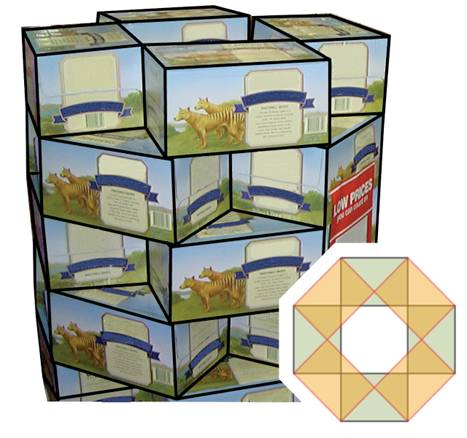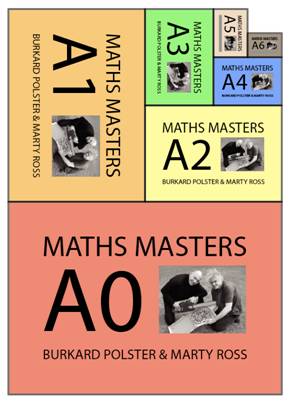The pleasure and pain of √2
by Burkard Polster and Marty Ross
The Age, 2 March 2009
As part of last year's National Science Week, the Mathematical Association of Victoria arranged for us to tour rural Victoria. Our mission was to convert kids into maths wizards. After a long and thirsty day of converting we went to a bottle shop, where we discovered a beautiful tower of beer cartons.

It is delightful how neatly the cartons fit together, forming an almost perfect octagonal base. This is only possible because the cartons have rectangular bases in the proportion √2:1. Rectangles of these proportions are famous for another magical property: taking such a rectangle and cutting it in half in the shorter direction, the result is two rectangles with the same proportions.
In fact, you see rectangles like this every day. Standard A4 paper, and all A-size paper, has sides in the proportion √2:1. This paper magic starts with an A0 piece of paper, one square meter in area. Cutting A0 paper in half gives A1 paper. Then cutting A1 paper gives A2 paper, and so on.

The advantages of this paper scheme become apparent when photocopying. Placing an A4 document on the copier and hitting the A4 > A3 button, the result is a perfect A3 copy. Or, placing two A4 pages side-by-side and hitting the A3 > A4 button, the two pages are perfectly reproduced onto one A4 page.
Alas, there is a hitch in this ingenious scheme: √2 is irrational. That is, √2 cannot be written as the ratio of two whole numbers. The upshot is that an A0 piece of paper should actually have sides of lengths 1189.207115... mm and 840.896415... mm.
It is obviously convenient to use whole number units, and in practice A0 paper is defined to have the dimensions 1189 mm x 841 mm. So the paper system is not quite perfect, though sufficiently accurate to work well in practice.
But for mathematicians, this slight imperfection is annoying. The irrationality of √2 demands the imperfection, and in fact there is long history of irrational numbers annoying mathematicians.
This began more than 2000 years ago, with the Pythagoreans. They only believed in whole number proportions, basing their philosophy upon this. So, they were extremely disconcerted when the irrationality of √2 popped up in their calculations. In fact, it was only in the 19th Century that mathematicians came to fully understand irrational numbers. And still, √2 pops up, proving that our paper system doesn't quite work. And still, we're annoyed!
Copyright 2004-∞ ![]() All rights reserved.
All rights reserved.